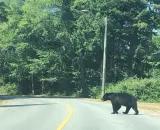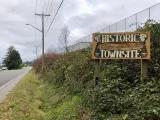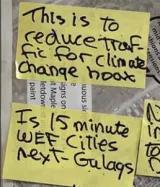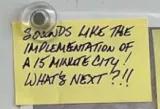
In a small Canadian town, bicycle infrastructure divides neighbors as conspiracy theories and misinformation take hold. Can this once tight-knit community come together again? An investigation into how disinformation can derail climate action at the local level.

This story is part of our 2023 Climate Disinformation Media Fellowships.
In spring of 2023, the City of Powell River received provincial government funding for traffic calming measures for one of its neighborhoods. This was very good news for people like Anastasia Lukyanova, the City's Sustainability Planner who has worked tirelessly for years advocating for more bike infrastructure and active transportation in the small, coastal town of British Columbia (BC), Canada. What Anastasia couldn't have anticipated is the intense push back and opposition the project would eventually face. A once tightly knit neighborhood would become so divided that neighbors who shared annual Christmas dinners with one another would no longer be on speaking terms.
Powell River is a town of a little more than 13,000 residents, around 170 kilometers northwest up the Sunshine Coast from Vancouver. It is a geographically isolated place, hemmed in by mountains and ocean. Bears are often spotted in the city’s streets, there are resident orcas seen year-round and bald eagles fill the air with their distinct chirping call. The trip from Vancouver includes two ferries, each of which crosses fjords that extend deep into the picturesque Coast Mountain Range. The longest highway in the world– The Pan-American highway, known as Highway 101 in BC, ends (or begins, depending on who you talk to) 30 kilometers north of Powell River, in a village called Lund.
Because of the isolated location of the community and the effort required to get there (you can only arrive by ferry or airplane), Powell River has a remote, end-of-the-road feel. People are proud to be from the region and some can be wary of change.
However, as housing prices in cities such as Victoria and Vancouver are out of reach for many people looking to put down roots and with remote working becoming more commonplace, smaller, more affordable towns like Powell River in BC have become more attractive. And with new people, come new ideas. Anastasia is a European transplant who moved to Powell River in 2017. Explaining how she and her partner chose to live in Powell River she says, “we were looking for a small, friendly community on the coast to buy a home and start a family. We spent about 6 years in Vancouver and wanted to make a change and relocate to a smaller city.”
Anastasia grew up around high-density housing and efficient public transit. She says that no one she knew had a car and that “it was normal not to have a car, the city was dense, and public transit was very frequent and convenient. My family back home still doesn't own a car and I only got my driver's license when I moved to Powell River.” After completing her Master’s degree in Mathematical and Statistical Sciences, Anastasia moved into the field of sustainability by working for a social enterprise where she helped businesses measure and reduce their carbon footprint.
A bicycle network for Powell River
A passionate member of the British Columbia Cycling Coalition, Anastasia can be seen biking around town in a “Bike & Walk & Bus & Trains” t-shirt. Since she began her role as Sustainability Planner at City Hall in 2019, she has been working on an all ages and abilities inclusive Bicycle Network Strategy. Anastasia says that many people “are interested in cycling but don't feel comfortable on a busy street next to traffic. This is why we developed the Bicycle Network Strategy– a plan to have a network of safe protected infrastructure connecting all key destinations in the community.” She continues to say that “having a safe network would enable many people to use bikes for transportation and that has many benefits - health, cost savings, and community connectedness.” The Bicycle Network Strategy was adopted by Council as part of the City of Powell River's 2021-2022 Strategic Plan.
Once the Strategic Plan was approved by City Hall, it needed to be implemented and the “Maple and Sycamore Safer Streets project” was proposed for the Townsite neighborhood. Townsite is a unique community in western Canada for its grid pattern with closely spaced Arts and Crafts style heritage houses. The community was planned around the Catalyst tiskwat Paper Mill which, in the early 1900s, was the world's largest producer of newsprint. The houses have well-maintained gardens, there are back alleys connecting the yards and, in 1995, Townsite became the only community in western Canada to receive the designation of National Historic District of Canada for being a “very well-preserved and progressive example of the earliest phase of planned 20th-century single industry communities in Canada''.
Maple Avenue and Sycamore Street in Townsite were identified for the Safer Streets project given the presence of a daycare, an elementary school and a high school in the area. A neighborhood “bikeway” would be created and furthermore, the Safer Streets project would create an extension on the active transportation link between Townsite and the Westview neighborhood a few kilometers away, with a bike path called the “mid-level connector” that is in the works.
A neighborhood bikeway is not a bike lane that is separated from the road. Neighborhood bikeways are meant to slow traffic down through the use of traffic calming measures such as speed cushions, curb extensions and speed limits. These urban design features are used across North America to promote pedestrian and cyclist safety. Participate Powell River, a website run by the city where residents can share ideas and “provide feedback on policy and planning”, states that “neighborhood bikeways do not separate bicycle and motor vehicle space, but instead use traffic calming measures to ensure safe and comfortable sharing of the street”.
From the City's perspective, the Maple and Sycamore Safer Streets project matched up with three key priorities of the City's Strategic Plan: Community health (active transportation and active living), economic resiliency (improved transportation), and climate change mitigation and adaptation. City planners such as Anastasia thought the bikeway wouldn't face much opposition because not only do bikeways cause minimal obstruction, but the highway runs parallel to Maple Avenue– just one street down. Emergency vehicles or anyone in a hurry could just as easily take the highway, rather than speeding through the residential streets.
The City of Powell River kicked the project off with a lot of community engagement. City workers went door-to-door with pamphlets outlining the goals and intent of the project. The public's input was sought through three open-door sessions. At first, the reaction was positive. Residents were supportive of the reduction in the speed limit from 50 km/h to 30 km/h and agreed that cyclist and pedestrian safety was a concern.
Nia Wegner is a longtime resident of Townsite who commutes by bike to work each day. She has had a bandage on her hand for a few weeks from a recent mountain bike accident as she spends her weekends on the trails. She said she has never felt safe having her teenage daughter bike to school down Maple Avenue and would welcome any kind of traffic calming measures and increased cycling awareness.
With a grant application deadline from the BC Active Transportation Infrastructure Grants Program approaching, the City hired an engineering company to develop a plan for the project. Although the reaction of the Townsite residents had largely been supportive, opposition started to build when people learned that a small portion of the street parking could be lost. One skeptical resident stated, “Our friendly neighborhood would become a war zone with residents fighting over a place to park their cars.” This is when members of the Townsite Ratepayers Society (TRS) began a door-to-door campaign to build a resistance and to stir up those who may have had some doubts about the Safer Streets Project.
Nia says that the leader of the TRS, someone who was already mistrustful of the City and opposed to change, “knew that parking would be the main issue that she could gain support with. She has rental homes and suites so has a vested interest.”
Pamphlets that the TRS distributed contained considerable disinformation about the project and about the City's broader intentions. The pamphlets stated that the streets were going to be converted into one-way streets, that ALL of the parking would be removed and that the City was implementing projects such as this to increase control over residents’ lives and mobility.
According to the engineers' preliminary design, 13% of parking along Maple Avenue would be removed to make space for the bumpouts. At the same time, the City's website states: “In Townsite, the Zoning Bylaw requires that vehicle access be provided via the lane where available, and each lot is required to provide two off-street parking spaces.”
Personal vehicles main source of greenhouse gas emissions
An “ecoCity Footprint analysis” report from 2016 finds that transportation is by far the largest source of greenhouse gas emissions in Powell River, with private vehicle travel contributing the most. The report shares an emissions inventory for the city and provides recommendations on ways to lower emissions. It states: “A near-term priority is to continue to electrify the vehicle fleet… and to reduce the number of vehicles on the road by promoting active transportation, transit, and car sharing… The long-term priority should be to promote compact communities that are designed for active transportation and transit.”
Flyn McCarthy has been living in Powell River since 2020 and is an expert in carbon and energy modelling. He has worked with large greenhouse gas emitters to develop decarbonization pathways and says that “we don't have a lot of other emissions sources. Vehicles are about 80 to 90% of the emissions here. Stopping driving is super quick, even if it's just eliminating a few trips per week, that can be significant. We have low emissions associated with other industries, especially since the mill closed down.”
Statistics such as these could build a stronger case for adding bike lanes to the transportation network, but some residents of Townsite did not take lightly to the threat of losing some of their parking for the benefit of cyclists. Comments from more recent community engagement sessions include “this is to reduce traffic for climate change hoax”, “we have a right to travel freely”, “the needs of the few (cyclists) should not impact the needs of the many”, “Most of the bike riders do not live on these streets. Only TAX PAYING RESIDENTS!”, and “cyclists already cycle down Maple. It is safe for cycling.”
Nia believes some residents have a blanket rejection to any change, no matter what is being proposed. “I think it’s how they approach possible change, rather than accepting and being willing to work with it, they can’t trust anyone in the process.” Many comments from the community engagement session reflect this– “leave Maple Ave and Sycamore St. ALONE. Leave it as it is,” “How does this plan benefit anyone? Maple is already a quiet functional SAFE street” and “Why change anything waste of money”.
Safer Streets project "turned personal"
Anger and frustration mounted as the TRS continued with their campaign. A petition was started, and the small but loud opposition started attending the community meetings on the topic of the Safer Streets project. According to Nia, one member of the TRS group went door-to-door to have her neighbors sign the petition. “When you have been neighbors for 20 years or more, you feel obligated to sign, even bullied into it. Some newer neighbors tried standing up to [a leading figure of TRS] and correcting her by showing the city plan; however, she was so passionate she was not in a place to listen. She had her supporters rallying her on.”
Eventually, many proponents of the project kept quiet and avoided the community meetings for fear of intimidation because they no longer felt their voices were being heard or would make any difference. Notes from the City’s Community Engagement Summary include comments like “the time I did spend at the 1st session… was tough to witness with some of the angry comments. The two people at my table were not really interested in the information or process, which was frustrating any real conversation about the details.”
Nia said that it seemed like the focus of the original discontent was spinning out of control and that people opposed to the project were now seeing it as an attack on their community and on their freedom. She goes on to say that “the key point to this divide in our community is that it was made personal... So when I say this safe streets project turned personal, people we have had dinner with, bought our daughter Christmas gifts, people we considered friends, were now no longer speaking to us…This is a big deal in Townsite because of how the houses are situated.”
Certain members of the TRS were working to convince community members that the City had malicious intentions. One member of this group began emailing the community every day and sharing disinformation on social media about the project, providing a constant stream of negativity. During community meetings, she created an “us against them” dialogue and the vernacular shifted to what the TRS was fighting for, rather than a discussion about the proposed project.
The continuous negative feed cultivated by those opposed to the bikeway resulted in an echo-chamber of disinformation reverberating throughout the Townsite community. Echo chambers are common on social media and can lead to polarization. People have the tendency to trust the information they receive from people within their social network and can be validated in their own beliefs by having those beliefs reflected back at them. The algorithmic bias on social media works to reinforce this and the content you see on social media is more often based on what you previously viewed than on reliability.
The spread of disinformation in Townsite: "We have the right to travel freely"
Climate disinformation is on the rise and social media is spreading common false narratives from the denial of the human role in climate change (or the very existence of climate change) to disbelief about the urgency of climate change to renewables being useless or dangerous to the media skewing the truth to spread panic. In a 2020 study published in WIREs Climate Change, researchers define disinformation as “deliberately false information which is deliberately created and spread to mislead, deceive, or influence public opinion or obscure the truth.”
Alongside the disinformation about the details of the City's plan, a relatively new campaign of disinformation about a French urban planning concept was starting to spread in Townsite. In practice, the idea behind the 15-Minute City, or “complete communities”, is simple: city dwellers should have access to daily essential services within a 15-minute walk or bike ride. The concept was conceived by Carlos Moreno, an academic and advisor to the mayor of Paris, Anne Hidalgo. It is intended to make neighborhoods more inclusive, socially cohesive and walkable, as well as providing ease of access to services and amenities. The 15-Minute City is “an urban planning concept that addresses our goals to reduce carbon emissions while also promoting physical activity through active transportation”, says Dany Doiron, managing director at the Canadian Urban Environmental Health Research Consortium.
However, in the past year or so, the 15-Minute City has been manipulated into a conspiracy where governments are at work to create “climate change lockdowns” and restrict the movement between neighborhoods by limiting vehicle travel. Ideas of surveillance cameras monitoring citizens’ movements and the requirement of special authorization to leave your residential area are being shared on social media.
In the past year, this conspiracy theory has gained popularity in many Canadian cities. For example, in Essex County, Ontario, community members filled a special public meeting with concerns about the division of the county into zones with travel restricted between them. In Edmonton, Alberta, some residents are claiming that the 15-Minute Districts, as they are called in the Edmonton City Plan, are being implemented to keep citizens locked in their own neighborhoods.
A Canadian psychologist and media commentator named Jordan Peterson has claimed to his 4.8 million Twitter/X followers that “the idea that neighborhoods should be walkable is lovely. The idea that idiot tyrannical bureaucrats can decide by fiat where you’re ‘allowed’ to drive is perhaps the worst imaginable perversion of that idea–and, make no mistake, it's part of a well-documented plan.”
Although the Safer Streets proposal does not include any of the core tenets of the 15-Minute City, this month, one Facebook user on the Powell River message board stated “If you buy into these stupid 15-minute city ideas you are helping turn BC into a socialist nightmare. All part of getting you to give up your car & ride a bike… All part of [Powell River’s] WOKE City agenda.”
In Canada, the 15-Minute City conspiracy has gained such momentum that the Canadian Institute of Planners put out a joint statement addressing threats to planning professionals and policies. The statement, from April 2023, expresses that “there is a growing concern across the country regarding the treatment of planners... as well as with the dissemination of misinformation related to planning principles and policies.” The statement goes on to say that the 15-Minute City has been vulnerable to “scrutiny and misunderstanding of its objectives” resulting in “alarming instances of hostile behavior and threats towards planners and public servants, disruptive conduct in consultation meetings.” Both Anastasia, the planner, and Nia, the Townsite resident, speak of intimidation and hostility at the community consultation and City Council meetings.
Some of Nia’s neighbors adhere to the conspiracy and see the City’s plans for increased bike and walkability to be linked to new lockdown measures. There are several references to the 15-Minute City conspiracy in the notes from community engagement workshops in the spring of 2023: “Is 15 minute [World Economic Forum] cities next – gulags” was one comment. Another was “sounds like the implementation of a 15 minute city! What's next?!!” Someone else suggested “if these proposed changes happen it would be easy for any authorities to fully block all access to implement their 15 minute city” and “Sounds like control to me!!”
Disinformation can lead to political inaction, and the rejection of or opposition to climate action and often leads to societal polarization, a distrust of science and the government. This polarization was happening in Townsite. Nia thinks some of her neighbors' strong reactions against the bikeway could be in part because this project was proposed on the heels of the COVID-19 pandemic. Many people were already feeling like the government was interfering too much in their lives, and they wanted their community to be left alone. She says, “after coming out of Covid many people were very vulnerable and needing community. This gave people a cause to come together. Whether positive or negative they took sides and put their energy into it.”
The City of Powell River has since modified the plan and scaled back the proposition. The down-scaled plan was approved, and the project will go ahead with the updated design. Reacting to the intense pushback and the curtailed plan, Anastasia is disheartened. “It feels very discouraging and sad. When we do public engagement about bike plans, we hear from many people who would love to see safer infrastructure but when we get pushback it feels that folks aren't aware that many people in the community need the ability to get around by bike safely to have a good quality of life.” She has heard from people injured in bike accidents due to lack of safe infrastructure and says, “it feels like we are living in our own bubbles and aren't aware of the needs of others.”
A community on the mend
Nia now starts each day with an early morning walk with one of her neighbors. She says this is helping her to work through what has happened in the neighborhood and talks about how they are determined to bring the community back together. “There is a group of us working… in hopes to help our community heal. It's bigger than just the one issue... but it deals with how to change the way we speak to not discriminate.” The method they are using advocates for a shift from the individual to the collective for a healthier and more sustainable society. “Change is a concept that is difficult for all but it’s how we approach it and carry on”, she says. Nia hopes that engaging with her neighbors in an intentional way will provide a way to “go back to core values and to connect as a community again.”
While the Townsite neighborhood of Powell River has been shaken and divided by the City's Safer Streets project, there is still hope for the future. “It’s very difficult and sad but because we truly care about our community, we will hopefully overcome this,” says Nia, who has lived there for decades. Anastasia also remains hopeful despite the progress being slower than she would like. “With many small towns putting in more bike infrastructure and with e-bikes making cycling accessible to more people, change is happening."











